Rotary International President for 2022 23, Jennifer Jones, wants Rotarians to imagine the possibilities in the change they can make to transform the world.




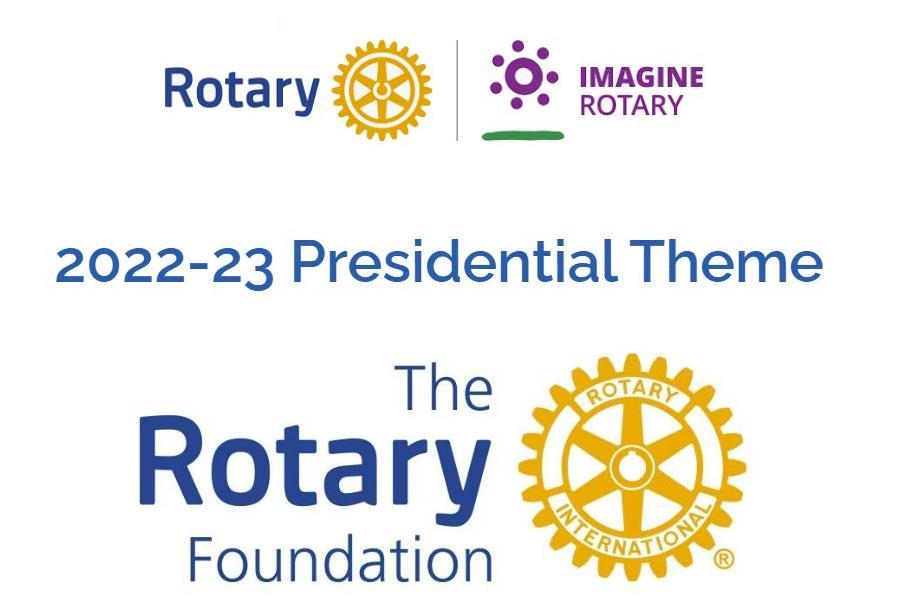

Rotary International President, Shekhar Mehta, India District 6330 Governor, Erin Shankie Club President, Joyce Nolin Capman (2021 22)
Jones, a member of the Rotary Club of Windsor Roseland, Ontario, Canada, urges us all to dream big and harness our connections and the power of Rotary to turn those dreams into reality.
December 2022 D6330 , 2020 Page 1 An onehttps://issuu.com/ladykitt/docs/march_newsletter_2021
Imagine, a world that deserves our best, where we get up each day knowing that we can make a difference.”
TABLE OF CONTENTS


Topic Page No.*
TRF† TRUSTEE CHAIR’s December Message 3 DECEMBER FOCUS DISEASE PREVENTION 4 How Rotary works 5 Pakistan 5 Berlin 6 Puerto Rico 7 Checkerboard 8
PARTNERS FOR MALARIA FREE ZAMBIA 9
Schedule a presentation 11 Fighting malaria is personal 12
A FOUNDATION MOMENT POLIO PLUS 13
TRFs Fund raising Challenge 14
Donating to The Rotary Foundation 15 POLIO NOW 16 Preparing for a post polio world 16 PAUL HARRIS SOCIETY 19
ROTARY’S BEGINNING continued 20 DECEMBER Disease Prevention 21
GETTING TO KNOW THE TRF TRUSTEES 22 Arch Klumph Society 22
UKRAINE & ROTARY 24 APPLY FOR A DISASTER GRANT 26 WAYS TO GIVE TO TRF 27 FOUNDATION GRANTS Areas of Focus 28 JANUARY THEME Vocational Service 29
ROTARY’S CORE VALUES 30 OBJECT OF ROTARY & FOUR WAY TEST 31 EREY Every Rotarian Every Year / Bequest Society 32
For the latest polio information, click here. Click here to make yourself smile!
December 2022 D6330 , 2020 Page 2
* Editor Kitty Bucsko
THE ROTARY FOUNDATION TRUSTEE CHAIR'S MESSAGE DECEMBER 2022
Our Shared Values
We all make hundreds if not thousands of decisions daily. Whenever I need to make an important decision, I remember the words od Roy Disney, who co founded what became the Walt Disney Co.: “It’s easy to make decisions when you know what your values are.”
Each of us brinvs a set of personal values into our clubs Rotary also unites by a set of core values service, fellowship, diversity, integrity, and leadership that guide our decisions and galvanize us to take action and, by doing so, change the world.
Another value is inextricable to Rotary: our giving spirit. From the club members who volunteer their time for service projects to the Rotary leads in the Arch Klumph Society who sustain our Foundation, Rotary memers are among the most generous people I have ever met. Cobining our personal generosity with the countless ways Rotary affords us to give back makes us a global force for good.
In Rotary, we take it a step further. We also value good stewardship, planning, and sustainability. Not only do we give, but in Rotary we also give smart. We know that building sustainability into our projects means their impact will be felt over the long term.
In short, through the Foiundation, your gifts keep on giving. This is why donating to The Rotary Foundation is one of the most intelligent decisions you can make. You know that your gift will align with those values you hold dear and that it will be administered by your fellow Rotarians, who share those values.
It is quite an understatement to say that in giving to Rotary, we also receive. As someone who has been privileged to visit hundreds of Foundation projects around the world, I can tell you that the gift we get in return is priceless.
I hope you, too, will be as lucky as I have been to see the look of amazement on the face of a person at an eye clinic in hennai India, who now sees clearly. The proud sjiles of Guatemalan children who learned to read thanks to Rotary. Or the grateful tears of a parent in Pakistan whose child has received two drops of polio vaccine. Then you will understand what I’m talking about. We are so fortunate to be able to serve humanity by supporting our Foundation.
During this season of giving, I thank you for your generosity to The Rotary Foundation and for all the ways you give to our great organization. Juliet and I extend our warmest holiday greetings to you all.
IAN H. S. RISELEY Foundation Trustee Chair

December 2022 D6330 , 2020 Page 3
DECEMBER FOCUS on DISEASE PREVENTION through THE ROTARY FOUNDATION

DONATE NOW

From https://www.rotary.org/en/our causes/fighting disease
WE BELIEVE GOOD HEALTH CARE IS EVERYONE’S RIGHT
Yet 400 million people in the world can’t afford or don’t have access to basic health care.
Disease results in misery, pain, and poverty for millions of people worldwide. That’s why treating and preventing disease is so important to us. We lead efforts both large and small. We set up temporary clinics, blood donation centers, and training facilities in underserved communities struggling with outbreaks and health care access. We design and build infrastructure that allows doctors, patients, and governments to work together.
Our members combat diseases like malaria, HIV/AIDS, Alzheimer’s, multiple sclerosis, diabetes, and polio. Prevention is important, which is why we also focus on health education and bringing people routine hearing, vision, and dental care.
December 2022 D6330 , 2020 Page 4
HOW ROTARY (and TRF‡) MAKES HELP HAPPEN Foundation stories
We educate and equip communities to stop the spread of life threatening diseases. Rotary members have hundreds of health projects underway around the world at any given time.
PAKISTAN AND NIGERIA REPLACE PAPER-BASED REPORTING WITH FAST, ACCURATE CELLPHONE MESSAGING
By Ryan Hyland Photos by Khaula Jamil
Mobile phones and simple text messaging may be the keys to victory in the world’s largest public health initiative: the eradication of polio.
As the disease retreats from the global stage, thriving in only a few remote areas in three countries, it’s up to health workers to deliver vaccines and share information with speed and accuracy.
Health workers in Pakistan are receiving cellphone and e monitoring training at the Rotary Resource Center in Nowshera, Khyber Pakhtunkhwa.
Rotary and its partners in the Global Polio Eradication Initiative are strengthening the lines of communication by giving cellphones to health workers in Pakistan and Nigeria, where a single text message could save a life.
In Pakistan, Rotary has been working to replace traditional paper based reporting of maternal and child health information, including polio immunization data, with mobile phone and e monitoring technology.
Community health workers across the nation have received more than 800 phones through a partnership with Rotary, the Pakistani government; Telenor, the country’s second largest telecommunications provider; and Eycon, a data monitoring and evaluation specialist. Organizers plan to distribute a total of 5,000 cellphones by the end of 2018.
‡ The Rotary Foundation
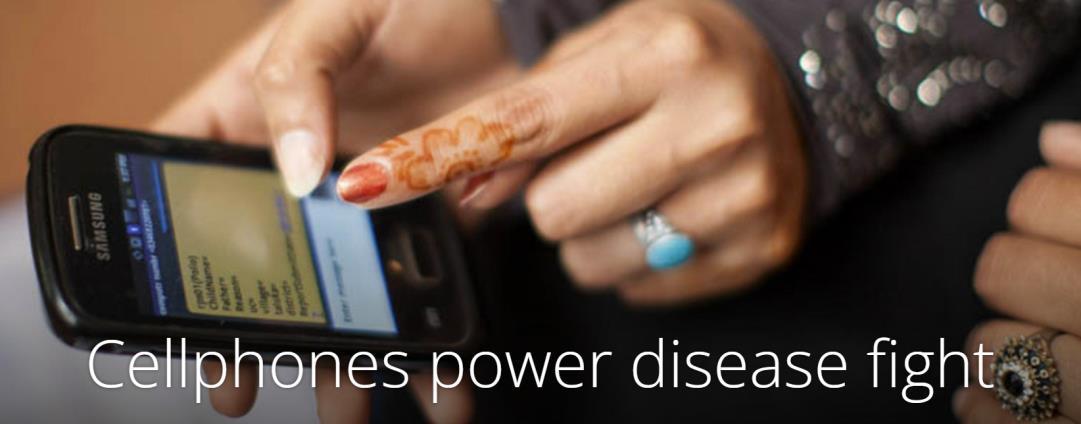
December 2022 D6330 , 2020 Page 5
Health workers can use the phones to send data via text message to a central server. If they see a potential polio case, they can immediately alert officials at Pakistan’s National Emergency Operations Center. They also can note any children who didn’t receive the vaccine or parental refusals and record successful immunizations. In Pakistan, the polio eradication effort aims to reach the nation’s 35 million children under age five.
The result is a collection of real time information that officials can easily monitor and assess, says Michel Thieren, regional emergency director of the World Health Organization’s Health Emergency Program.
Pakistan health workers are replacing traditional paper reporting with accurate and timely cellphone based reporting.
“Cellphone technology signals tremendous progress in the polio eradication program,” says Thieren, who has directed polio related initiatives for WHO in Pakistan. “The data we collect needs to have such a granular level of detail. With real time information that can be recorded and transcribed immediately, you can increase accuracy and validity.
At right, Health workers in Pakistan are receiving cellphone and e monitoring training at the Rotary Resource Center in Nowshera, Khyber Pakhtunkhwa.


Click here for a very short video showing cell phone e monitoring
“This gives governments and polio eradication leaders an advantage in the decisions we need to make operationally and tactically to eliminate polio,” Thieren says.
Click here to read more

BERLIN, GERMANY
In Berlin, 100,000 refugees have overtaxed the health care system, jeopardizing the lives and well being of refugees and German citizens alike.
Rotarian Dr. Pia Skarabis Querfeld has assembled medical professionals from her community to assist. The members of the volunteer teams are highly motivated to serve vulnerable people and to work together to help their community.
Click here to view a short video telling this remarkable story
December 2022 D6330 , 2020 Page 6
AFTER HURRICANE MARIA TORE THROUGH PUERTO RICO, local Rotary members continue to rebuild homes and lives
 By Vanessa Glavinskas Photos by Alyce Henson
By Vanessa Glavinskas Photos by Alyce Henson
Eladio Montalvo faced a stark choice: risk drowning in his one story home or climb through a window into the house next door. It was under construction but had a second floor where he could escape the rising floodwaters.
He boosted his dog through and scrambled in after him. The two huddled inside an upstairs bathroom for 22 hours while Hurricane Maria raged over Puerto Rico. With 155 mph winds and torrential rains, Maria was the strongest hurricane to hit the island in more than 80 years.
After the storm, Montalvo went out to see what was left of the home he had lived in since 1958. The walls were standing, but the water inside had risen chest high. Everything was destroyed. Without any family nearby, he had nowhere to go. He moved into his car.
“But after the storm came the calm,” he says. “Good people came.”
Montalvo lives in a fishing town called El Maní outside the city of Mayagüez on the island’s west coast. He invites his guests inside to see the progress he has made adding a shower to his bathroom. There’s a pile of tiles that he plans to lay soon, and he has started painting the walls a light shade of blue. The home is neatly but sparsely furnished: a bed, a TV, and a few plastic bins, including one labeled camisas that has shirts and shorts tucked inside.
At left, Rivera greets Eladio Montalvo, who was forced to live in his car before the Mayagüez Rotary club helped him rebuild his home.

Click here to read and learn more.

December 2022 D6330 , 2020 Page 7
Faustino Rivera pats Montalvo affectionately on the shoulder. It’s September 2018, a year since Hurricane Maria, and Rivera and several other members of the Rotary Club of Mayagüez have stopped by to visit.
OTARY MEMBERS FROM DURANGO, COLORADO, USA, TEAM WITH THE Navajo Nation to bring solar lights to remote, off-the-grid homes on the country’s largest Native American reservation.
By Kate Sieber Produced by Stuart Cleland
After decades of crafting squash blossom necklaces, pendants, and bracelets, Jerry Domingo knew he would have to quit making jewelry, because he couldn’t see very well anymore.
Navajo like Jerry Domingo are caught in isolated pockets of land, which are called The Checkerboard.
A sturdy Navajo grandfather, silversmith, and revivalist preacher, Domingo lives in a one room house smaller than a single car garage in the windswept sagebrush desert near Nageezi, New Mexico.
His home is mere miles from the picturesque badlands Georgia O’Keefe painted and Dzilth Na o Dithle, the sacred portal where the Navajo believe the first people came out of the earth. But it’s a long distance from all that the modern world seems to promise grocery stores, jobs, medical care. Domingo’s home is new. It has unpainted walls, plywood floors, and a wood stove but no insulation or electricity.
In a twist to his story, electric lines traverse the land just a few hundred yards from Domingo’s front door, but with all of the permissions and work required by the utility, it would cost more than $30,000 to connect to the power.
Domingo, who has pewter hair and a broad, calm face, first started making jewelry in the 1970s, when he went to work in his uncle’s shop. Over the years, he honed his craft, and customers started to come to him to commission works.
Now he sells his wares when he travels to preach all over the reservation. But with his failing eyesight, it has been getting harder to do the detailed work. After all, it takes a good four days to make a full squash blossom necklace. Jerry Domingo creates jewelry by the light of a window in his home in The Checkerboard.
At night, the glow of kerosene lamps is too dim. Even during the day, the home’s interior is full of shadows, making it difficult to tease, hammer, and solder metal into art.
“When I do silverworking, I have to wait until the sun comes through the window,” said Domingo, wearing a thick Dallas Cowboys sweatshirt to insulate himself against the chill and large turquoise rings on his fingers, as he worked on a necklace more than a year ago. “I can’t really know what I’m doing when it’s dark in here. It would make a whole lot of difference just to not be in the dark.”
Through a pastor at a local church, Domingo found out about a program through a Rotary club in Durango , Colorado, USA, that brings solar powered lighting to remote homes on the Navajo reservation.

Click here to read more
Click here to view a short video telling this story.
Click here to view a very short video explaining why electricity is scarce in the Checkerboard.
December 2022 D6330 , 2020 Page 8
R
Joe Williams hugs Irene Guerito after installing solar lights in her home on the Navajo reservation


December 2022 D6330 , 2020 Page 9
Malaria is a formidable foe: Responsible for 50% of all infant deaths and 20% of all maternal deaths in Zambia.
On March 9th, 2021, Rotary International, World Vision, and the Bill & Melinda Gates Foundation announced the launch of Rotary’s first Program of Scale, Partners for a Malaria-Free Zambia, a $6 million investment to train, equip and deploy 2500 Community Health Workers in Zambia.


Partners for a Malaria Free Zambia will strengthen the national health system by working closely with local health officials and health facility staff, scaling up Rotary’s successful work in the Copperbelt Province to reduce malaria by 90% in two additional Zambian provinces.
Malaria Partners International (MPI) is a Rotarian led organization advocating for malaria elimination.

As an independent 501(c)(3), we have created strong strategic partnerships within Rotary and in the global health community. Our partners include PATH/MACEPA, the Bill & Melinda Gates Foundation, World Vision, Pilgrim Africa, Alliance for Malaria Prevention, Malaria No More, the President’s Malaria Initiative, and the Peace Corps.
Since 2009, when MPI was founded, we have facilitated dozens of anti malaria projects in nine nations and, through that work, have developed strong relationships with leadership at Ministries of Health and national malaria elimination programs throughout Sub Saharan Africa.
Early in the Programs of Scale process, Malaria Partners International began discussions with two of our key partners, World Vision and the Gates Foundation, about how we might collaborate with Rotary to leverage Rotary’s $2M investment for greater scale and sustainability. Those discussions, which took place over many months, led to a commitment from both partners that they would match Rotary’s investment to create a $6 million program.
Led by the Rotary Club of Federal Way, Partners for a Malaria Free Zambia will relieve over 1.3 million Zambians from the burden of malaria, bringing together Rotary clubs across the U.S. and Zambia to provide community based malaria education, testing, and treatment.
Malaria Partners International is proud to serve in an advisory capacity for Partners for a Malaria Free Zambia, helping unite and coordinate the amazing teams and organizations bringing their all to this project.
Click here to view a recording of a Partners for Malaria free Zambia Webinar that took place in April of 2021.
December 2022 D6330 , 2020 Page 10
Click here to locate this link and schedule a speaker for the district or for your club


Click here to learn more.
 By Eric Liswaniso, Program Manager Malaria Partners Zambia
By Eric Liswaniso, Program Manager Malaria Partners Zambia
When Partners For a Malaria Free Zambia launched in Lusaka about a year and a half ago, our goal was clear; train, equip and deploy 2,500 community health workers in 10 malaria high burden districts across 2 provinces in Zambia. Today, we are proud to announce that that target has been met.
Click here to read more on the magic number of 2500.

December 2022 D6330 , 2020 Page 11
By Eric Liswaniso, member of the Rotary Club of Ndola and the Rotaract Club of Lusaka, Zambia
One of the most frustrating things about malaria is the preventable suffering it imposes on families. The death of a child or a parent, the loss of work, or economic stability can be devastating.
I lost my parents quite early, and life became very difficult for me and my siblings. Fortunately, with help from family members, I was able to complete my education and support my younger siblings through their schooling.
But my experience awakened me to the misfortune of many others, for whom losing a parent leads to a lifetime of suffering. I’m now a husband and the father of a two year old daughter, so fighting malaria which particularly affects children under five and pregnant women is personal.
Four years ago, I joined the Rotaract Club of Lusaka, Zambia, to serve my community. When I moved to Ndola to do malaria prevention work, I joined the Rotary Club of Ndola. As a program manager for the organization Malaria Partners Zambia, my professional work contributes directly to ending malaria in this country. It has become my calling. We want to give our children a fair chance of survival and help them thrive by bringing health services closer to them.
In my new role, I help mobilize Zambian and international Rotary members as part of the Partners for a Malaria Free Zambia program, which in 2021 became the first member led project to receive The Rotary Foundation’s $2 million Programs of Scale grant.
With additional funds from World Vision U.S. and the Bill & Melinda Gates Foundation, we’ll have $6 million to carry out a three-year program to recruit, train, and support 2,500 community health workers to combat malaria. They’ll test for, diagnose, and treat malaria as well as pneumonia, diarrhea, and other preventable diseases among more than 1.2 million Zambians, mostly in hard to reach areas.
Click here to read why ridding Zambia of Malaria is personal


December 2022 D6330 , 2020 Page 12
WHAT IS POLIO PLUS?
Ending polio is Rotary’s main humanitarian goal, and PolioPlus is the program that supports these efforts.
It was launched in 1985 with help from Dr. Albert Sabin, the developer of the oral polio vaccine, as a worldwide program to protect children from the paralyzing consequences of polio. Rotary later became a founding member of the Global Polio Eradication initiative.


Since then, the incident of wild polio cases has decreased by 99.9 per cent and the wild polio virus remains endemic in only two countries, Afghanistan and Pakistan.
The processes that Rotary helped build to fight polio have also been used to protect communities from COVID 19 and other diseases. This illustrates the Plus in PolioPlus.
But Polio anywhere is a threat to children everywhere. Only global eradication will ensure that no child suffers its devastating effects ever again.
December 2022 D6330 , 2020 Page 13
WHAT IS ROTARY’S POLIO FUNDRAISING CHALLENGE?
Rotary is committed to raising US$50 million every year for polio eradication. Through our partnership with the Bill & Melinda Gates Foundation, every $1 of that is matched 2 to 1.
Raising both funds and awareness and mobilizing volunteers are among Rotary’s primary roles as a partner in the Global Polio Eradication Initiative. Withour members, we’ve contributed more than $2.6 billion to fight polio, including matching funds from the Gates Foundation, and Rotary vollunteers have dedicated countless hours to protecting children everywhere.
You can take action and raise awareness throughout the year, not just on World Polio Day which has recently pass on October 24.
Help end polio by making a gift to the PolioPlus Fnd at endpolio.org.
How do you want to get involved in the causes you’re most passionate about?

THE ROTARY FOUNDATION - ROTARY'S OWN CHARITY
The Rotary Foundation is a not for profit corporation enabling Rotarians and their partners to achieve sustainable solutions to global problems. Widely recognised as being in the top 5 for Best Value Charity Giving, it celebrated its 1st 100 years in 2017
The Mission of the Rotary Foundation updated October 2021
The mission of the Rotary Foundation is to enable Rotary members to advance world understanding, goodwill, and peace through the improvement of health, the support of education, and the alleviation of poverty. The Foundation is a not for profit corporation supported solely by voluntary contributions from Rotary members and friends of the Foundation who share its vision of a better world. This support is essential to make possible projects, funded with Foundation grants, that bring sustainable improvement to communities in need.
Click here for more information.
December 2022 D6330 , 2020 Page 14
WHEN YOU DONATE TO TRF
Thank you to everyone in D6330 who has given to the Foundation, who has participated in a Foundation project, or has helped spread the word about the Foundation. Thank you!
Click here to view a short video about your contributions to TRF and the good that you do! We’re changing lives through our vision and unwavering commitment, bringing hope to those who need it most.




December 2022 D6330 , 2020 Page 15
For more information, click here http://polioeradication.org/polio today/polio now/this week/


Click here to learn the difference between Wild Polio Virus (WPV) and Vaccine derived Polio Virus. (VDPV)
GPEI - WHO WE ARE
The Global Polio Eradication Initiative. The Global Polio Eradication Initiative is a public private partnership led by national governments with six partners the World Health Organization (WHO), Rotary International, the US Centers for Disease Control and Prevention (CDC), the United Nations Children’s Fund (UNICEF), Bill & Melinda Gates Foundation and Gavi, the vaccine alliance. Its goal is to eradicate polio worldwide.
PREPARING FOR A POLIO-FREE WORLD
A polio free world requires updated vaccination policies, including the phased withdrawal of oral polio vaccines (OPV), appropriate containment of the poliovirus in facilities, certification that polio has been eradicated, and planning for the transition of knowledge and infrastructure to serve other health goals.
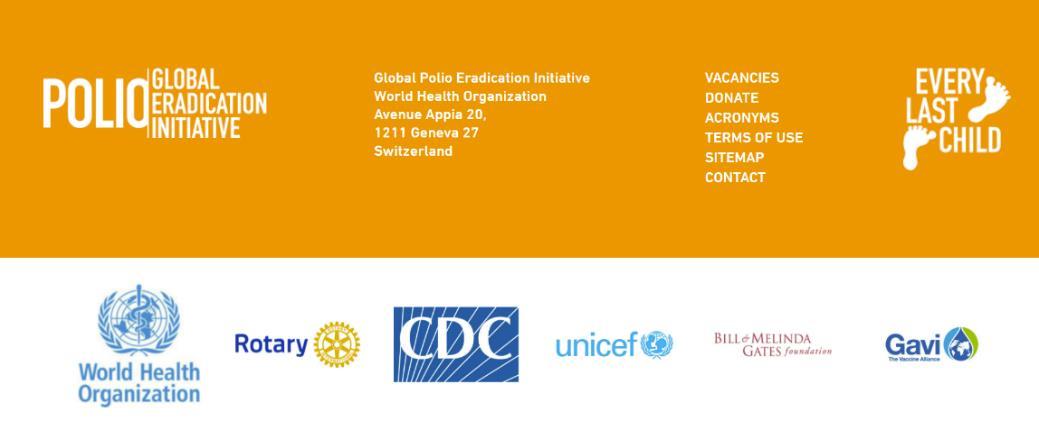
OPV CESSATION WHY?
Oral polio vaccine (OPV) is extremely safe and effective at protecting children against lifelong polio paralysis. Over the past 10 years, more than 10 billion doses of OPV have been given to nearly three billion children worldwide. More than 16 million cases of polio have been prevented, and the disease has been reduced by more than 99 percent. It is the appropriate vaccine through which to achieve global polio eradication.
December 2022 D6330 , 2020 Page 16
OPV contains attenuated (weakened) polioviruses. On extremely rare occasions, use of OPV can result in cases of polio due to vaccine0associated paralytic polio (VAPP) and circulating vaccine derived polioviruses (cVDPVs). For this reason, the global eradication of polio requires the cessation of all OPV in routine immunization, as soon as possible after the eradication of wild poliovirus (WPV) transmission.
Click here to read more.
CONTAINMENT WHAT IS CONTAINMENT?
Containment includes biosafety and biosecurity requirements for laboratories, vaccine production sites, or any other facility that handles or stores eradicated polioviruses, to minimize the risk of these viruses being released into the community. Containment also concerns risk mitigation measures associated with field use of some live oral polio vaccines. Containment of eradicated polioviruses is a key objective of Polio Eradication and Endgame Strategic Plan 2019 2023, and will be critical for maintaining global polio free status.
Two of three strains of wild poliovirus have been declared globally eradicated. In September 2015, the Global Commission for the Certification of Eradication of Poliomyelitis declared wild poliovirus type 2 as eradicated, and in October 2019, wild poliovirus type 3 followed. Laboratories and facilities worldwide, however, still handle or store the viruses for activities such as vaccine production and research. Further, live type 2 or type 30containing oral polio vaccines continue to be used across the world for outbreak response or routine immunization.
Click here to read more.
CERTIFICATION
Certification of polio eradication is conducted on a regional basis. Each region can consider certification only when all countries in the area demonstrate the absence of wild poliovirus transmission for at least three consecutive years in the presence of certification standard surveillance.
In addition, all facilities holding wild poliovirus infectious and potentially infectious materials must have implemented bio containment measures according to the Global action plan for laboratory containment of wild poliovirus (2003).
Region
Year Certified Wild polio free
WHO African Region 2020
WHO Region of the Americas 1994
WHO South East Asia Region 2014
WHO European Region 2002
WHO Eastern Mediterranean Region
WHO Western Pacific Region 2000
Click here to read more.
December 2022 D6330 , 2020 Page 17
TRANSITION PLANNING
Transition planning is a critical part of preparing for a polio free world. The polio transition process aims to secure the infrastructure set up to eradicate polio and use it to support stronger, more resilient health systems. Over many years, the GPEI has built significant infrastructure for disease surveillance, social mobilization, and vaccine delivery; developed in depth knowledge and expertise; and learned valuable lessons about reaching the most vulnerable and hard to reach populations on earth.
As we come closer to eradicating polio, GPEI resources are being redirected away from polio free countries to focus on achieving the two core goals of the Polio Eradication Strategy 2022 2026 eradicating wild polio ad responding to polio outbreaks. In polio free countries, WHO and UNICEF, together with the national governments are working to ensure that critical infrastructure is transitioned to support broader health priorities. This will ensure that the most vital assets and staff are sustained to support health systems far into the future, especially in the areas o essential immunization, emergency preparedness and response and keeping the world polio free. At WHO, this work is guided by the Strategic Action Plan on Polio Transition (2018 2023) Transition activities are overseen by the Polio Transition Independent Monitoring Board (TIMB).
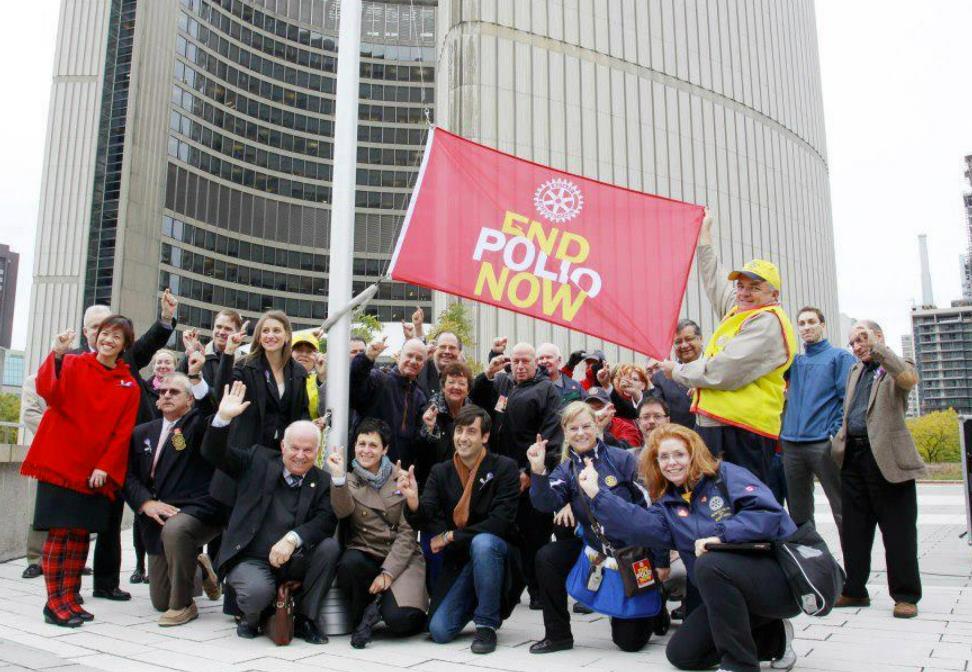
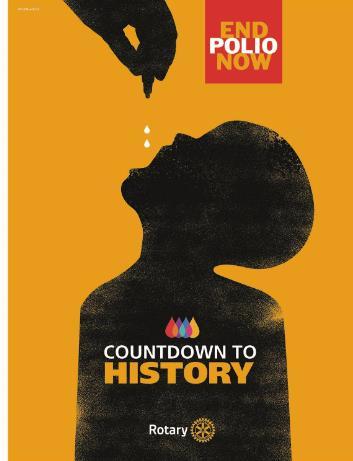
Click here to read more.
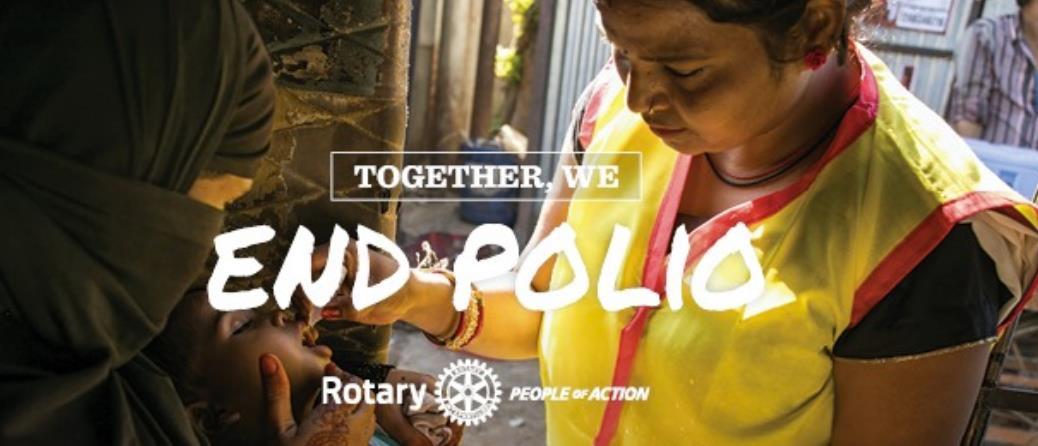
December 2022 D6330 , 2020 Page 18
PAUL HARRIS SOCIETY
The Paul Harris Society recognizes Rotary members and friends of The Rotary Foundation who elect to contribute $1,000 or more each year to the Annual Fund, PolioPlus Fund, or approved global grants.
The purpose of the Paul Harris Society is to honor and thank individuals for their generous, ongoing support of The Rotary Foundation.
What your giving supports
Supporting families and changing lives! By giving from your heart each and every year, you’ll support families and change lives. Paul Harris Society gifts have helped provide:
• Vocational training for teachers establishing an early childhood education center in South Africa
• Water filters, toilets, and hygiene training to prevent fluorosis, diarrhea, and other diseases in India
• A scholarship for a medical professional in Italy to research treatments that minimize mortality rates among premature babies
• Peace building seminars for 200 teachers and 1,300 students in Uganda
• Treated mosquito nets and medical services that prevent malaria in Mali
In District 6330, Rotarian Jamie Pole is the District Paul Harris Society Chair.
• In District 6330 we are proud to have over 116 members in our Paul Harris Society.


• We have over 32 of our clubs that now have members in the Paul Harris Society.
• For information please contact our District 6330 Co ordinator, Jamie Pole
December 2022 D6330 , 2020 Page 19
The Beginnings of Rotary –
continued from last month
The First Years of Rotary
Within a year, the Chicago club had become so large it became necessary to adopt the now common practice of a regular meeting place
The next four rotary clubs were organized in cities in the western United States, beginning with San Francisco, then Oakland, Los Angeles, and Seattle. The National Association of Rotary Clubs in America was formed in 1910. In April 1912, Rotary chartered a club in Winnipeg, Manitoba, Canada, marking the first acknowledged establishment of an American-style service club outside the United States. To reflect the addition of a club outside the United States, the name was changed to the International Association of Rotary Clubs in 1912
In August 1912 the Rotary Club of London received its charter from the Association, marking the first acknowledged Rotary club established outside of North America. It later became known that the Dublin club in Ireland had been organised before the London club, its first meeting having been held on February 22, 1911, but the Dublin club di not receive its charter until after the London club was chartered.
During World War I, Rotary in Britain increased from 9 to 22 clubs, and other early clubs in other nations included those in Cuba in 1916, Philippines in 1919, and India in 1920 In 1922, the name was changed to Rotary International. By 1921, Rotary had grown to 2,106 clubs worldwide with110,500 members.

Nazi Germany and World War II in Europe
In Germany, no club had been formed before 1927, because of opposition from the continental clubs. For a while after 1933, Rotary clubs “met with approval” by Nazi authorities and were considered to “opportunity for party comrades … to provide enlightenment regarding the nature and policy of the National Socialist Movement.” The Nazis, though they saw international organizations as suspect, had authorized National Socialist German Workers' Party (NSDAP) members to be members of Rotary through the Nazi Party’s court rulings issued in 1933, 1934, and 1936. In 1937, more than half the German Rotarians were Nazi Party members.
Six German clubs were4 formed after Hitler came to power. They came under pressure almost immediately to expel their Jewish members.
Rotary Clubs do not appear to have had a unified policy towards the Nazi regime: while several German Rotary clubs decided to disband their organizations in 1933, others practiced a policy of appeasement or collaborated. In Munich, the club removed from its members’ list a number of Rotarians, Jewish, and non Jewish, who were politically unacceptable for the regime, including Thomas Mann (already in exile in Switzerland). Twelve members resigned in sympathy with the expelled members.
December 2022 D6330 , 2020 Page 20
Beginning in 1937, however, hostile articles were published in the Nazi press about Rotary, comparing Rotary with Freemasonry. Soon after that, the incompatibility between Nazism and the international humanitarian organization resulted in two decisions which would jeopardize the existence of Rotary in Germany: in June 1937, the ministry of the interior forbade civil servants to be members of Rotary; in July, the NSD/aO’s party court reversed its previous rulings and declared party and Rotarian membership incompatible as from January 1938.
Source: https://rotary1.org/101 things about rotary/
December Disease Prevention and Treatment Month


Rotary’s continued involvement in Disease Prevention and Treatment will need to be directed toward finding solutions to many health issues while continuing to fight against existing and emerging disease threats.

As a Rotarian, you have been enlisted as being a part of that fight. Thanks for all you do to support these important initiatives.
The Rotary Foundation is changing the world by providing grants for projects and activities around the globe.
December 2022 D6330 , 2020 Page 21
GETTING TO KNOW THE ROTARY FOUNDATION TRUSTEES
3 more featured this month
The Board of Trustees manages the business of The Rotary Foundation, the charitable arm of our organization that funds service activities. The RI president-elect nominates the trustees, who are elected by the RI Board to four year terms.
Aziz Memon Trustee 2020-24
Rotary Club of Karachi Pakistan
Aziz Memon is chair of the Kings Group, a conglomerate of five companies that is one of the leading textile and ready made garment manufacturing and exporting groups in Pakistan. He is also chair of the board of the Karachi Garment City, a project of the government of Pakistan. Memon’s other roles include honorary consul general of the Republic of Suriname in Karachi, president of the English Speaking Union of Pakistan, and president of the United Memon Jamat of Pakistan, a nongovernmental organization dedicated to community development and helping the underprivileged.
Since he joined Rotary in 1995, he has been widely recognized for his leadership in polio eradication. Memon has served as member of the International PolioPlus Committee and chair of the Pakistan PolioPlus Committee. He has worked closely with Rotary’s partners and stakeholders, including UNICEF, WHO and its Expanded Programme on Immunization, government officials, religious scholars, celebrities, business leaders, and Rotarians from around the world. He was one of four polio eradication activists to receive the Louis Pasteur Medal by the Institut Pasteur. His other RI leadership positions have included training leader, committee member, and RI president’s representative. Memon says his favorite Rotary project was working with his club to raise over $285,000 to fund an English language instruction school for 4,000 children.
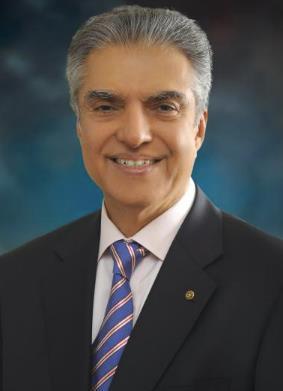
Memon has received the Service Above Self Award, the International and Regional Service Awards for a PolioFree World, and The Rotary Foundation’s Distinguished Service Award and Citation for Meritorious Service. In recognition of his community and humanitarian services in the health sector, the president of Pakistan conferred the Pride of Performance Award on Memon in 2011. He and his wife, Samina, are members of the Arch Klumph Society.
Akira Miki
Trustee 2021 25 Rotary Club of Himeji Japan
Akira Miki, a dentist with his own practice, dedicated himself to disaster recovery projects after the January 1995 Hanshin Awaji earthquake, one of the worst earthquakes to hit Japan in the 20th century. Miki worked on building a children’s home and supported children who needed emotional care.
Miki joined Rotary in 1981. He served on the RI Board of Directors from 2018 to 2020 and a special advisor for the Foundation Trustees in 2020 21. Previously, his

December 2022 D6330 , 2020 Page 22
leadership roles in RI have included serving as RI president’s representative, training leader, governors elect trainer, committee member, assistant Rotary coordinator, Council on Legislation representative, and sergeant at arms for international conventions and assemblies. He is director of the RI Japan Youth Exchange Committee. He visited Washington, USA, as a short term youth exchange student. He has been a strong advocate for youth development. Since 1985, he has led the district RYLA seminar, the All Japan RYLA Institute, and the All Japan Interact Institute.
Miki is a former Interactor and a recipient of The Rotary Foundation’s Citation for Meritorious Service. He and his wife, Chiharu, are members of The Arch Klumph § Society, Benefactors, and Major Donors to The Rotary Foundation.
Bharat S. Pandya Trustee 2022 26 Rotary Club of Borivli Maharashtra, India

Bharat Pandya is a practicing general and laparoscopic surgeon. He and his wife, Madhavi, a gynecologist, own a private hospital in Mumbai. He is a fellow of the International College of Surgeons and has served on the board of the Jan Shikshan Sansthan vocational training institute, sponsored by the Indian government.
Pandya joined Rotary in 1989 as a charter member of his club. During his year as governor of District 3140, his district contributed over $2 million to The Rotary Foundation, making it the top contributor worldwide for 2006 07. He has led numerous projects, including water and sanitation projects funded by Foundation grants that installed check dams so that villagers no longer needed to walk up to four miles per day to collect water.
Pandya has served Rotary, as Director, RI Treasurer, regional RI membership coordinator, training leader, and member of Rotary’s Membership, Strategic Planning, Leadership Development and Convention Promotion committees and on the India PolioPlus Committee.
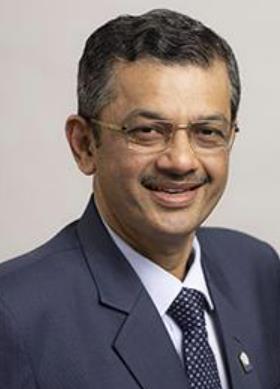
He has received the Service Above Self Award, the Rotary Foundation Citation for Meritorious Service, and the Rotary Foundation Distinguished Service Award. He and Madhavi are Level 2 Major Donors to the Foundation.
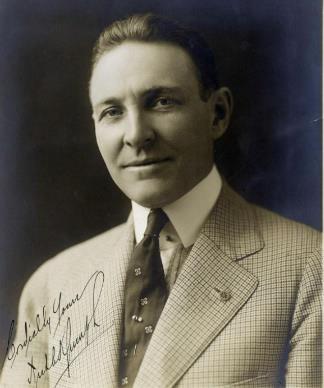
Click here to read the story of Arch Klumph, the father of The Rotary Foundation
Named after the Sixth President of Rotary, the Arch Klumph Society recognizes The Rotary Foundation’s highest tier of donors those who have contributed $250,000 or more during their lifetime.
December 2022 D6330 , 2020 Page 23
Arch Klumph
ROTARY IN UKRAINE
A convoy of nearly 40 ambulances wound its way from Slovakia, around mountains and through roadblocks, military checkpoints, and torrential rain to arrive in Kyiv, bringing the critically needed vehicles to Ukrainian government officials.

Rotary is responding to the crisis in Ukraine. Learn what we’re doing.
By Ryan Hyland
The US$600,000 initiative was the first joint project between Rotary and Ukraine Friends**which agreed in July to collaborate to provide resources, organize logistics, and distribute funds for high impact projects that help Ukrainians affected by the war with Russia. Each organization donated US$300,000 to get the ambulances, and Rotary districts in Ukraine and Slovakia coordinated the delivery. Rotary's funding came from a Rotary Foundation disaster response grant.
After a journey of about 870 kilometers (540 miles) that took more than twice as long as it would have in normal circumstances, the convoy arrived on 27 September at Mariinsky Park in Kiev.

Brock Bierman, the CEO of Ukraine Friends and a member of the Rotary Club of Staunton, Virginia, USA, says the logistics of moving that many vehicles to another country would always be difficult, and doing it across
** WeareaU.S.basednon profitdedicatedtodeliveringcriticalhelpinUkrainebyprovidinghumanitarianaidasneedsevolve,refugeesupport andafocusonrecoveryandreconstruction.
December 2022 D6330 , 2020 Page 24
a border into a war zone was especially complex. Yet the ambulances were delivered without any major incidents.
“I don’t think the trip could’ve gone any better,” says Bierman, who was at Mariinsky Park for the arrival. “The way people worked together to get this done was spectacular.”
Ukraine Friends secured the ambulance drivers, while Rotary District 2232 in Ukraine and Belarus bought the fuel. The ambulances are equipped with oxygen tanks, defibrillators, electrocardiogram machines, mechanical ventilators, and other medical equipment.



Twenty two of the ambulances were procured by Rotary District 2240 in Czech Republic and Slovakia and went to the Department of Health for civilian use. Ihor Kuzin, Ukraine’s deputy minister of health, was there to see the transfer of ambulances.


Click here to read more
Click here to read and learn more!
December 2022 D6330 , 2020 Page 25
Apply
for a disaster response grant
Find out how Rotary districts can apply for a grant from the Disaster Response Fund.
Now through 31 December 2022, districts can apply for grants to provide relief such as water, food, shelter, medicine, and clothing to refugees or other people affected by the crisis. Districts should work closely with local officials and groups to ensure that the funding will meet a specific community need.
Ukraine has 62 Rotary clubs and six satellite clubs with about 1,100 members, and 24 Rotaract clubs with more than 300 members. District 2232 (Ukraine and Belarus) formed a committee to help people affected by the crisis


December 2022 D6330 , 2020 Page 26
WAYS TO GIVE TO THE ROTARY FOUNDATION
Your donation changes lives! and this information bears repeating…
There are numerous ways to support The Rotary Foundation.
Every amount contributed to The Rotary Foundation is spent in support of humanitarian, educational, and cultural programs and their operations. Clubs and districts apply for and receive Foundation grants to carry out worthy projects worldwide.

Here are a few of the ways that your contribution can make a difference:
• $100 can buy textbooks for one elementary school in Zambia
• $5,000 can buy vaccine to immunize 10,000 children against polio
• $24,000 can buy an academic year Rotary Foundation Ambassadorial Scholarship
• $100,000 can buy funding for two to complete a two-year graduate program for a Rotary World Peace Fellow
Donate Online
When you donate online, you get to choose where your donations go. Support thousands of service projects our people of action are tackling around the world. Outright gifts can be made easily with The Rotary Foundation online contribution form.
This method expedites processing your tax receipt and Paul Harris Fellow recognition points. For online donations please visit https://www.rotary.org/en/donate.
• Memorial or Tribute Donations: A gift to The Rotary Foundation is a meaningful way to honour a loved one.
• Recurring Donations: Rotary Direct allows you to help year round by automatically giving each month, quarter, or year

December 2022 D6330 , 2020 Page 27
The Rotary Foundation the Engine that runs Rotary!
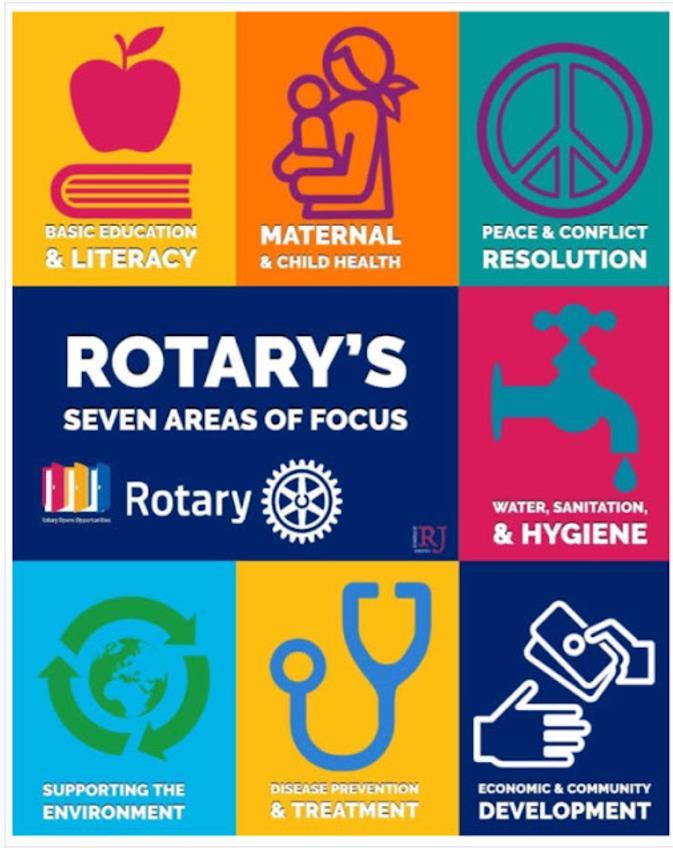
December 2022 D6330 , 2020 Page 28
FOUNDATION GRANTS must fall into one of Rotary’s 7 Areas of Focus
COMING IN JANUARY



Vocational Service gives Rotarians the opportunity to help others to escape poverty and gain a measure of self respect. As business and professional leaders, we have a duty to lead and encourage good ethics through vocation. Carlos Frum, PDG D6440



December 2022 D6330 , 2020 Page 29
ROTARY’S CORE VALUES
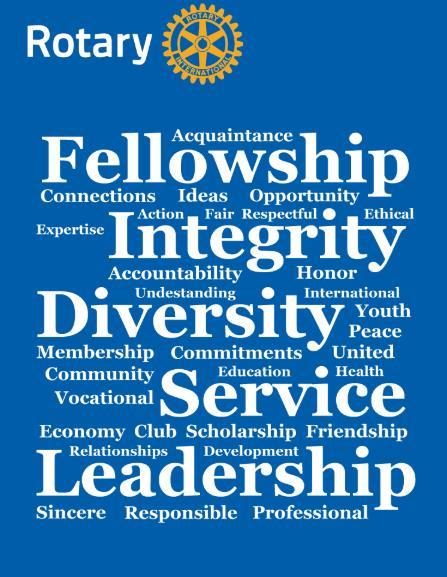
WHAT IS ROTARY?
Rotary International is an international service organization whose stated purpose is to bring business and professional leaders in order to provide humanitarian service and to advance goodwill and peace around the world. It is a non-political and non-religious organization.
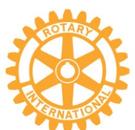
December 2022 D6330 , 2020 Page 30
Click the 4 way test above to hear the Four Way Test by RC of Saskatoon Nutana
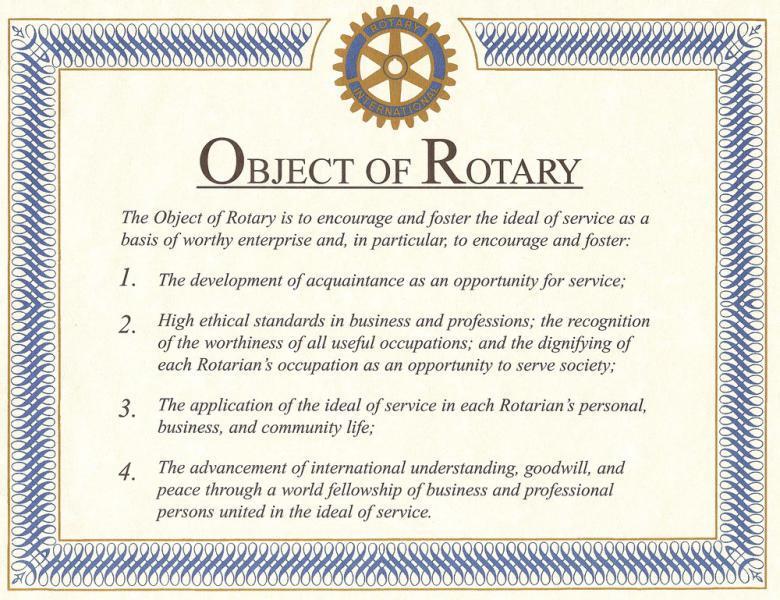
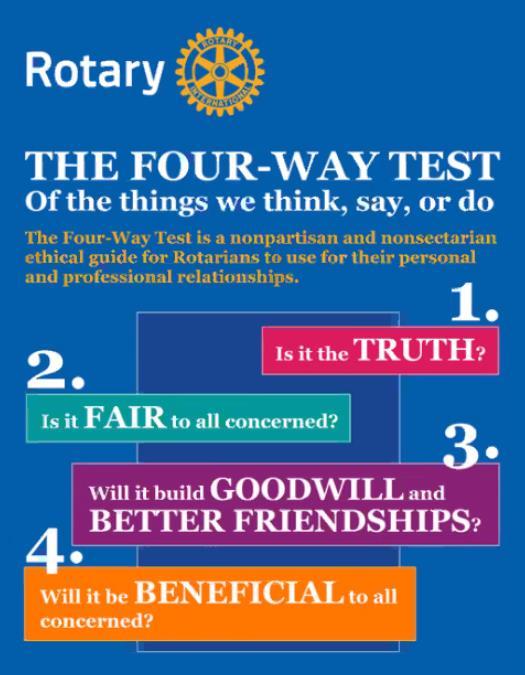
December 2022 D6330 , 2020 Page 31
THE ROTARY FOUNDATION EREY – Every Rotarian Every Year


Click here for a short video.
Our Every Rotarian, Every Year (EREY) initiative encourages all Rotary club members to contribute something each year to The Rotary Foundation. We hope that you can consider at least $100 USD every year to help us reach our goal to support the Rotary Foundation financially each year.
Sustaining member. One who contributes $100 USD every year is a Sustaining Member. With EREY, we encourage you to contribute an amount you can afford every year.
ROTARY BEQUEST SOCIETY
What is a Rotary Foundation Bequest Society Member?
Those who have made commitments for future gifts of $10,000 or more to The Rotary Foundation are invited to join the Bequest Society.
Donors may elect to receive various benefits and recognition pieces commemorating their commitment at each new recognition level, including pins, crystals, named funds, and special seating at the Rotary International Convention.


A bequest gift of at least $10,000 in your name to The Rotary Foundation creates a legacy of your generosity and compassion as you are helping many people live better lives around the world.
Today there are over 18,000 Bequest Society Members worldwide.
Will you join them by leaving a gift to Rotary in your estate? Contact the Rotary Foundation’s Planned Giving team
December 2022 D6330 , 2020 Page 32
But no -
When tomorrow comes, this day will be gone forever. In its place is something that you have left behind. Let it be something good.


December 2022 D6330 , 2020 Page 33
















 By Vanessa Glavinskas Photos by Alyce Henson
By Vanessa Glavinskas Photos by Alyce Henson























































